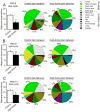The impact of maternal neglect on genetic hyperactivity
- PMID: 27449202
- PMCID: PMC4990781
- DOI: 10.1016/j.bbr.2016.07.033
The impact of maternal neglect on genetic hyperactivity
Abstract
Early environmental conditions are increasingly appreciated as critical in shaping behavior and cognition. Evidence suggests that stressful rearing environments can have an enduring impact on behaviors in adulthood, but few studies have explored the possibility that rearing environment could exacerbate genetic hyperactivity disorders. Uncovering a strong environmental influence on the transmission of hyperactivity could provide novel avenues for translational research. Recently we developed a selectively bred High-Active line of mice to model ADHD, providing a unique resource to address the question of environmental transmission. The High-Active line demonstrates transgenerational hyperactivity, but the influence of the postnatal environment (i.e. maternal care provided by dams) on hyperactivity had not been systemically quantified. This study employed a cross-fostering method to simultaneously address 1) whether High-Active and Control pups are provided with similar levels of care in the early environment, and 2) whether any differences in rearing environment influence hyperactive behavior. High-Active dams demonstrated impairment in all measures of maternal competence relative to Controls, which reduced survival rates and significantly reduced the body mass of offspring in early life and at weaning. While the deteriorated postnatal environment provided by High-Active dams was ultimately sufficient to depress Control activity, the hyperactivity of High-Active offspring remained unaffected by fostering condition. These data not only confirm the power of genetics to influence hyperactivity across generations, but also provide evidence that early rearing environments may not have a significant impact on the extreme end of hyperactive phenotypes.
Keywords: Genetic hyperactivity; Maternal care; Postnatal stress; Pup retrieval; Selective breeding.
Copyright © 2016 Elsevier B.V. All rights reserved.
Figures





Similar articles
-
Cross-fostering selectively bred High Runner mice affects adult body mass but not voluntary exercise.Physiol Behav. 2021 Nov 1;241:113569. doi: 10.1016/j.physbeh.2021.113569. Epub 2021 Sep 3. Physiol Behav. 2021. PMID: 34481826
-
Impact of intra- and interstrain cross-fostering on mouse maternal care.Genes Brain Behav. 2008 Mar;7(2):184-92. doi: 10.1111/j.1601-183X.2007.00337.x. Epub 2007 Jun 29. Genes Brain Behav. 2008. PMID: 17608702
-
Early weaning deprives mouse pups of maternal care and decreases their maternal behavior in adulthood.Behav Brain Res. 2005 Jul 30;162(2):200-6. doi: 10.1016/j.bbr.2005.03.013. Epub 2005 Apr 9. Behav Brain Res. 2005. PMID: 15970216
-
Developmental plasticity of HPA and fear responses in rats: a critical review of the maternal mediation hypothesis.Horm Behav. 2006 Dec;50(5):667-80. doi: 10.1016/j.yhbeh.2006.06.015. Epub 2006 Aug 7. Horm Behav. 2006. PMID: 16890940 Review.
-
Long-term neurobehavioural impact of the postnatal environment in rats: manipulations, effects and mediating mechanisms.Neurosci Biobehav Rev. 2003 Jan-Mar;27(1-2):57-71. doi: 10.1016/s0149-7634(03)00009-5. Neurosci Biobehav Rev. 2003. PMID: 12732223 Review.
Cited by
-
The impact of early-life environment on absence epilepsy and neuropsychiatric comorbidities.IBRO Neurosci Rep. 2022 Nov 9;13:436-468. doi: 10.1016/j.ibneur.2022.10.012. eCollection 2022 Dec. IBRO Neurosci Rep. 2022. PMID: 36386598 Free PMC article. Review.
-
Striatal transcriptome of a mouse model of ADHD reveals a pattern of synaptic remodeling.PLoS One. 2018 Aug 15;13(8):e0201553. doi: 10.1371/journal.pone.0201553. eCollection 2018. PLoS One. 2018. PMID: 30110355 Free PMC article.
-
Rearing by foster Wistar mother with high level of maternal care counteracts the development of genetic absence epilepsy and comorbid depression in WAG/Rij rats.Dokl Biol Sci. 2017 Mar;473(1):39-42. doi: 10.1134/S0012496617020077. Epub 2017 May 16. Dokl Biol Sci. 2017. PMID: 28508204
-
Impaired experience-dependent maternal care in presynaptic active zone protein CAST-deficient dams.Sci Rep. 2020 Mar 23;10(1):5238. doi: 10.1038/s41598-020-62072-1. Sci Rep. 2020. PMID: 32251313 Free PMC article.
References
-
- Heim C, Binder EB. Current research trends in early life stress and depression: review of human studies on sensitive periods, gene-environment interactions, and epigenetics. Experimental neurology. 2012;233(1):102–11. - PubMed
-
- Dudley KJ, Li X, Kobor MS, Kippin TE, Bredy TW. Epigenetic mechanisms mediating vulnerability and resilience to psychiatric disorders. Neuroscience and biobehavioral reviews. 2011;35(7):1544–51. - PubMed
-
- Levine S. Developmental determinants of sensitivity and resistance to stress. Psychoneuroendocrinology. 2005;30(10):939–46. - PubMed
-
- Maguire SA, Williams B, Naughton AM, Cowley LE, Tempest V, Mann MK, Teague M, Kemp AM. A systematic review of the emotional, behavioural and cognitive features exhibited by school-aged children experiencing neglect or emotional abuse. Child: care, health and development. 2015;41(5):641–53. - PubMed
Publication types
MeSH terms
Grants and funding
LinkOut - more resources
Full Text Sources
Other Literature Sources

